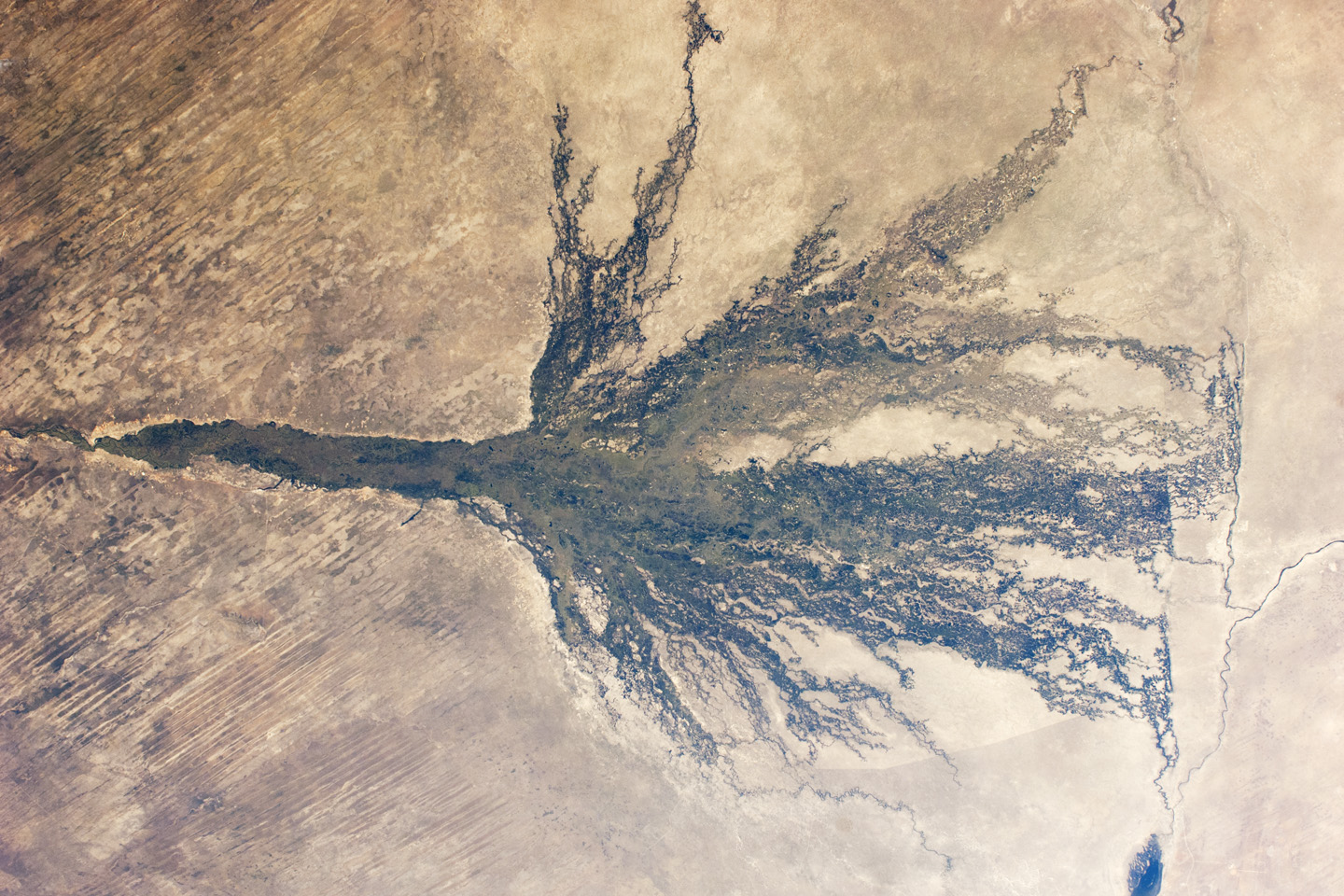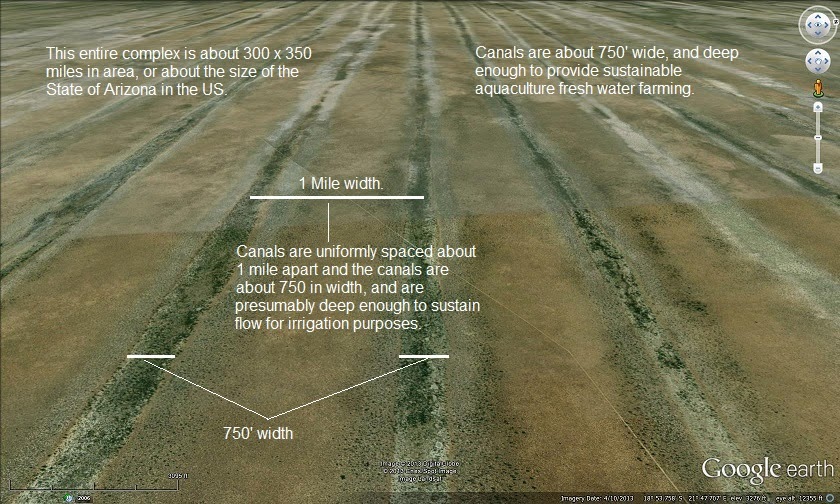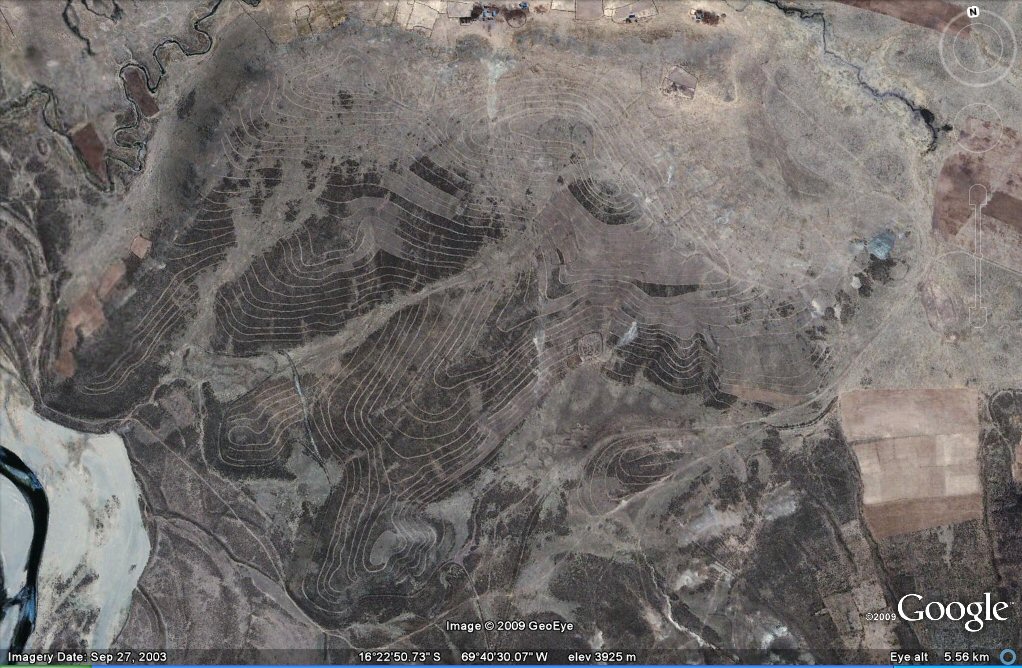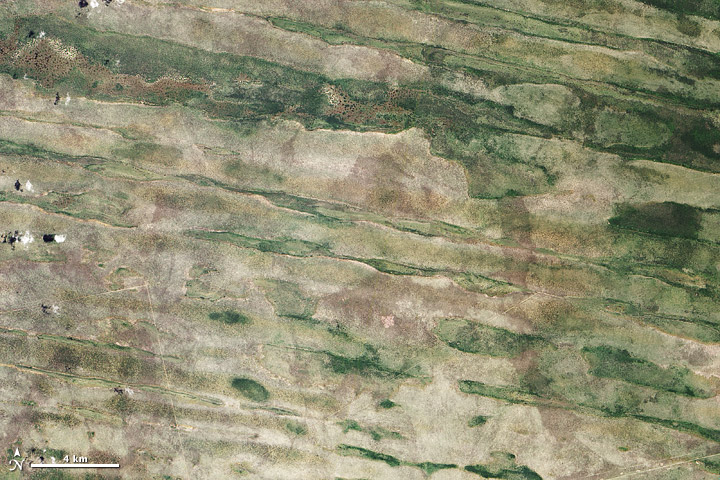 That could be right, but in close-up they do not look like linear sand dunes:
That could be right, but in close-up they do not look like linear sand dunes: 
Posted on 01/03/2015 4:10:32 PM PST by Fred Nerks
From my Free Web Book 'AncientCanalBuilders.com'
The largest wide-array man made (or at least non natural) structure in the world is in fact an ancient terra formed systems of agricultural-aquaculture canals in Northwestern Botswana and Northeastern Namibia, north of the Kalahari Desert in Southern Africa. Obviously quite ancient, the canal systems no longer provide free flowing water throughout its 105,000 mile array, but many sections show obvious intention to provide cross sectional irrigation.
These canals are too evenly spaced over too large an area to be any kind of natural formation. Based on entry and exit points, it is readily apparent this system is a very large, controlled agronomy array and/or aquaculture system. Its age is defined by the overgrown nature of the canals, as well as some areas that are covered over with drift and sand erosion.
The entire complex covers an area about equal in size to the State of Arizona in the USA. The canals are an integrated system of apparent irrigation and agricultural (and probably aquaculture) design. The system is about 350 miles in width and about 300 miles in depth. (For the remnants still visible.) This system represents roughly 67 MILLION acres of sustainable agriculture. Given the sophistication of design, it is entirely plausible to assume an above average yield, i.e. feeding well over 90 persons per acre on an annual basis. The system may or may not have provided a sustainable aquaculture (marine farming) environment. I have no reason to suspect that it did not.
Given the size and scope of this complex, (canals are about 1 mile apart on average) and collectively are roughly 350 X 300 miles in a rough rectangular format. (At least the observable parts) There could be, and probably is, much more to this complex than what is visible to the naked eye. Right now, we can identify ancient cultivation of roughly 105,000 square miles.
One square mile = 27,878,400 square feet, or 640 acres, so the entire complex had a sustained producing land mass of (640 acres x 105,000 square miles) or > 67,200,000 acres. (That is 67 MILLION acres)
One linear mile of canal had (750' width x + >12' depth x 5,280') = 47,520,000 cubic ft of water per linear mile.
Entire canal length (105,000 miles x 47.5 million cubic ft per mile) = 5,000,000,000,000 (That's 5 TRILLION) cubic feet of water in the canals. It would be an incredible waste of time and effort to irrigate >105,000 square miles of sustainable agriculture land, and not use the 5 trillion cubic feet of water circulating in the canals for aquaculture farming. I don't think the builders were that stupid.
Different estimates of the numbers of people this sustainable system would supply varies widely, though it is generally accepted that a system like this, if properly managed would provide a complete annual diet for somewhere between 60 to 120 people per acre. Which means this system was in fact providing food for an average of about 5 Billion people.
This array is in fact the largest non natural artifact on the Planet. It can be clearly viewed unaided from the International Space Station at roughly 230 miles up, which cannot be said for any other non natural feature on Earth.
I would suggest that depth of canal(s) must have been significant to compensate for general slight variations in elevation. There seems to be an average elevation variation of about 60', sometime more, and sometimes less.
Your comments are welcome, or you can contact me here:
johnmjensenjr@gmail.com 321-614-5040
First brought to my attention by Gary Schoening Here is his original Vimeo post: http://vimeo.com/64351951
The circles are very new and relates to the area being used to set up land speed records, or testing fast cars. This was posted by Tony Lockhart on July 14, 2012 3:04, on the website PMhttp://forums.naimaudio.com/topic/strange-patterns-in-south-africa-on-google-earth?reply=17476120013605872 "I know this area quite well although I have never been to the verneukpan. These patterns are new, I have an aerial photo from 2009 that shows only the triangle shape. The spirals are about 60 metres across, the smaller ones about 20m. Also apart from the triangle, there are some older looking straight line marks all over. The yellow line thru the triangle shape is the only "road" that traverses the pan, so I would guess that this is some form of grading or preparation work for making a hard standing, maybe for the record attempt base camp." Reply NewsKnowledgeJuly 16, 2013 at 3:04 AMAccording to friend of the farmer: If you look at Google Earth pictures of 2006 and prior, you will notice that there are no ditches present, only a few dams. The farmer that owns the land on which the spirals that you see is situated, took a tractor and used a plough to make deep spiralshape ditches with the intention of catching the water run-off. These ditches work very well and had a significant effect of improvement on the grazing on that farm. I wonder why, and does this work catching the water run-off? I mean running water would just flatten it all out again?
 That could be right, but in close-up they do not look like linear sand dunes:
That could be right, but in close-up they do not look like linear sand dunes: 



The farmer and his tractor immediately reminded me of the two old men who supposedly made the crop circles in England with a stick and a long piece of string. Thousands of them.
If you are interested, may I suggest you follow the patterns on Google Earth, and when you have covered enough territory way beyond that one salt pan, and you find that the patterns change shape and go on forever...you’ll forget all about the farmer and his tractor.
If you are interested, may I suggest you follow the patterns on Google Earth, and when you have covered enough territory way beyond that one salt pan, and you find that the patterns change shape and go on forever...you’ll forget all about the farmer and his tractor.
...
Has this been studied by scientists or just bloggers?

Bfl
A lot of this 'stuff' is the result of people using Google Earth. There aren't enough scientists with enough funds to follow all of it, not if it can't be attributed to global-warming. How about the contour irrigation images from South America? You can find them yourself:

http://earthobservatory.nasa.gov/IOTD/view.php?id=51190
Search for “linear dunes”. Nothing exciting.
Your link provides the answer. The features are natural linear sand dunes some tens of thousands of years old:
In far northeastern Namibia, there is a skinny stretch of land sandwiched between Angola, Botswana, and Zambia. The Caprivi Strip receives more than 600 millimeters (24 inches) of mean annual rainfall and experiences periodic floods, making it almost moist compared to the much drier parts of the country.
On February 1, 2012, the Advanced Land Imager (ALI) on NASA’s Earth Observing-1 (EO-1) satellite captured this natural-color image of the Caprivi Strip just north of the Okavango River (visible in the large image). Here the land is striped, as if a giant had dragged a rake over the landscape. Those stripes are linear dunes, and some are more than 100 kilometers (60 miles) long. Their presence suggests much drier conditions in the past.
Dunes generally form from wind-blown sand over many years. One characteristic of linear dunes is that they tend to remain intact long after the dry conditions cease. And because they don’t migrate like marching dunes, linear dunes preserve dirt and rocks that geologists can later use to understand past conditions.
A study published in 2000 sampled dunes throughout the Caprivi region and found that they likely formed under arid conditions between roughly 60,000 and 20,000 years ago. A study in 2003 concluded that dune construction may have been especially pronounced between 36,000 and 28,000 years ago. After the dunes formed, conditions in the Caprivi Strip moistened enough for the dunes to support vegetation—woodlands on the dune ridges, and grasses and shrubs in the valleys between.
Although studies indicate that conditions in this region were drier when the dunes formed, the dune-building periods seem to have been punctuated by humid periods, as indicated by sediments found in nearby caves and ancient lake sediments. About 16,000 years ago, a humid period prompted the filling of Etosha Pan. Now a saltpan, Etosha withered partly due to drying climate, but also because of changes in river routes.
References
Eitel, B., Blümel, W.D., Hüser, K. (2004) Palaeoenvironmental transitions between 22 ka and 8 ka in monsoonally influenced Namibia. Paleoecology of Quaternary Drylands, 102, 167–194.
Thomas, D.S.G., O’Connor, P.W., Bateman, M.D., Shaw, P.A., Stokes, S., Nash, D.J. (2000) Dune activity as a record of late Quaternary aridity in the Northern Kalahari: new evidence from northern Namibia interpreted in the context of regional arid and humid chronologies. Palaeogeography, Palaeoclimatology, Palaeoecology, 156(3–4), 243–259.
Thomas, D.S.G., Brook, G., Shaw, P., Bateman, M., Haberyan, K., Appleton, C., Nash, D., McLaren, S., Davies, F. (2003) Late Pleistocene wetting and drying in the NW Kalahari: an integrated study from the Tsodilo Hills, Botswana. Quaternary International, 104(1), 53–67.
Warren, A. Etosha: From Sand to Sea. PBS: The Living Edens. Accessed April 5, 2012.
NASA Earth Observatory image created by Robert Simmon and Jesse Allen, using Advanced Land Imager data from the NASA EO-1 team. Caption by Michon Scott.
Instrument(s): EO-1 - ALI
http://earthobservatory.nasa.gov/IOTD/view.php?id=77605
Wouldn’t the flood have destroyed these canals as well? I can’t seem to find the date for them.
Thanks for the info. You can clearly see the remnant of the pan on Google Earth.
Obviously, we're talking about a different climate than prevails today. I wonder what the dating actually is...
Don’t see how the technology existed to make that many parallel lines that perfectly straight for that long of a distance.
It all began with “If you build it, they (H20 molecules) will come.”
In far northeastern Namibia, there is a skinny stretch of land sandwiched between Angola, Botswana, and Zambia. The Caprivi Strip receives more than 600 millimeters (24 inches) of mean annual rainfall and experiences periodic floods, making it almost moist compared to the much drier parts of the country.
On February 1, 2012, the Advanced Land Imager (ALI) on NASA’s Earth Observing-1 (EO-1) satellite captured this natural-color image of the Caprivi Strip just north of the Okavango River (visible in the large image). Here the land is striped, as if a giant had dragged a rake over the landscape. Those stripes are linear dunes, and some are more than 100 kilometers (60 miles) long. Their presence suggests much drier conditions in the past.
Dunes generally form from wind-blown sand over many years. One characteristic of linear dunes is that they tend to remain intact long after the dry conditions cease. And because they don’t migrate like marching dunes, linear dunes preserve dirt and rocks that geologists can later use to understand past conditions.
A study published in 2000 sampled dunes throughout the Caprivi region and found that they likely formed under arid conditions between roughly 60,000 and 20,000 years ago. A study in 2003 concluded that dune construction may have been especially pronounced between 36,000 and 28,000 years ago. After the dunes formed, conditions in the Caprivi Strip moistened enough for the dunes to support vegetation—woodlands on the dune ridges, and grasses and shrubs in the valleys between.
Although studies indicate that conditions in this region were drier when the dunes formed, the dune-building periods seem to have been punctuated by humid periods, as indicated by sediments found in nearby caves and ancient lake sediments. About 16,000 years ago, a humid period prompted the filling of Etosha Pan. Now a saltpan, Etosha withered partly due to drying climate, but also because of changes in river routes.
References
Eitel, B., Blümel, W.D., Hüser, K. (2004) Palaeoenvironmental transitions between 22 ka and 8 ka in monsoonally influenced Namibia. Paleoecology of Quaternary Drylands, 102, 167–194.
Thomas, D.S.G., O’Connor, P.W., Bateman, M.D., Shaw, P.A., Stokes, S., Nash, D.J. (2000) Dune activity as a record of late Quaternary aridity in the Northern Kalahari: new evidence from northern Namibia interpreted in the context of regional arid and humid chronologies. Palaeogeography, Palaeoclimatology, Palaeoecology, 156(3–4), 243–259.
Thomas, D.S.G., Brook, G., Shaw, P., Bateman, M., Haberyan, K., Appleton, C., Nash, D., McLaren, S., Davies, F. (2003) Late Pleistocene wetting and drying in the NW Kalahari: an integrated study from the Tsodilo Hills, Botswana. Quaternary International, 104(1), 53–67.
Warren, A. Etosha: From Sand to Sea. PBS: The Living Edens. Accessed April 5, 2012.
NASA Earth Observatory image created by Robert Simmon and Jesse Allen, using Advanced Land Imager data from the NASA EO-1 team. Caption by Michon Scott.
Instrument(s): EO-1 - ALI
http://earthobservatory.nasa.gov/IOTD/view.php?id=77605

That might just be the answer...
It's just one person's interpretation. It looks like the close-up image might have been selected to show a region that accentuated the parallel lines/dunes.
Having spent a bit of time going over the area I’m not convinced they are in any way a man made feature. They look more like a combination of structural trends, and/or dune (aeolian or shallow water) features modified and enhanced by overland flow during heavy rainfalls.
That’s my geological $0.02 worth
Disclaimer: Opinions posted on Free Republic are those of the individual posters and do not necessarily represent the opinion of Free Republic or its management. All materials posted herein are protected by copyright law and the exemption for fair use of copyrighted works.